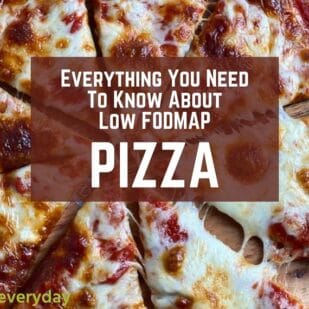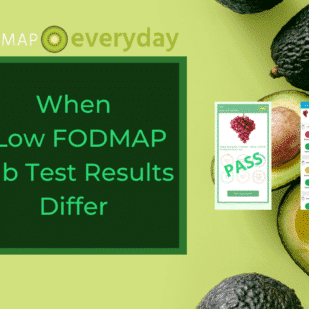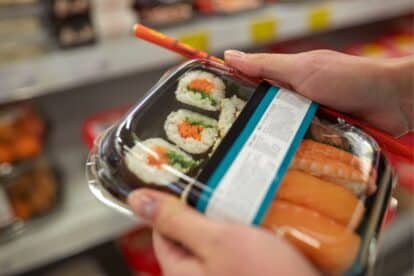FODMAP Friendly completely updated their smartphone app in early 2022; this article explains their lab testing system, how to use the app – and why you should be using it. The app is free and contains primary, trustworthy FODMAP information.
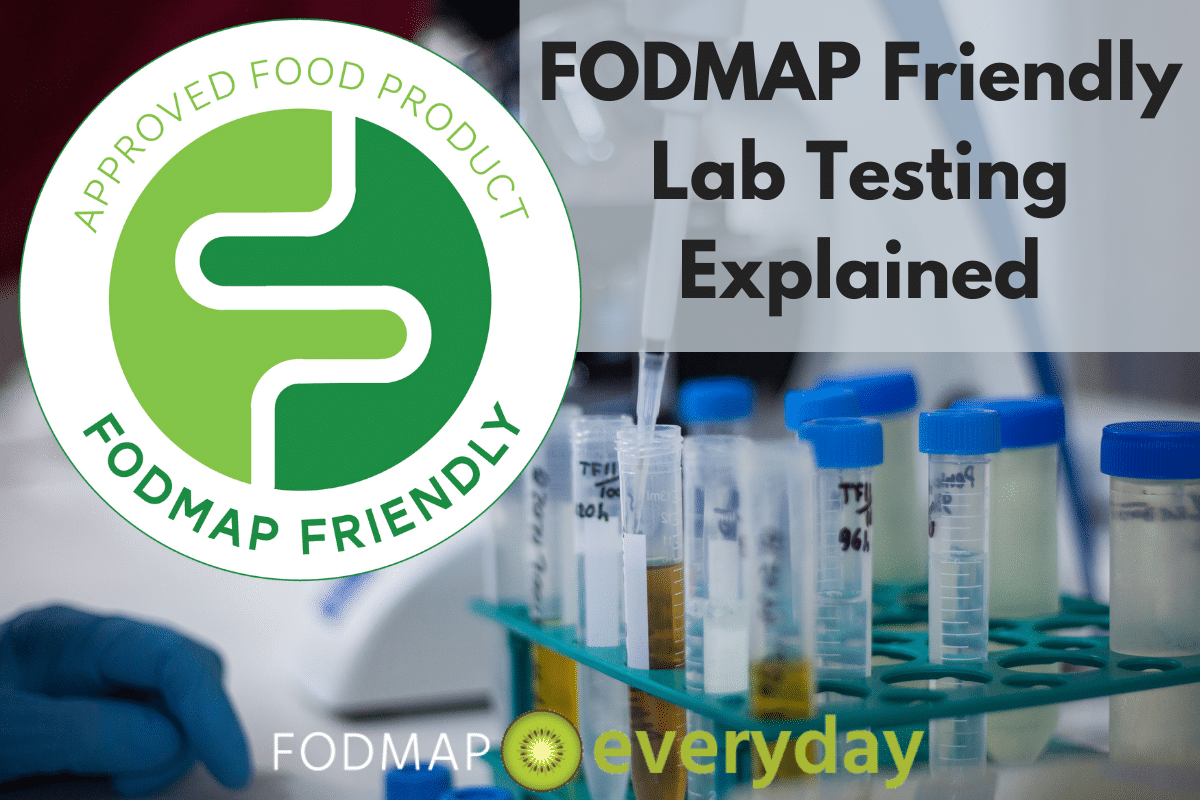
Who Is FODMAP Friendly?
When you first learn about the low FODMAP diet you will hopefully also hear the terms “FODMAP Friendly” and “Monash University”, because these are the primary resources the public has for FODMAP information. Note that I have capitalized “FODMAP Friendly”; more on that in a moment. Here’s the background.
Who Developed The Low FODMAP Diet?
Research on the gut’s reaction to individual FODMAPs has been going on for years, but it started to really come together in the early to mid 2000s. In 2004 or 2005 researchers at Monash University agreed upon the FODMAP acronym (Monash itself has published both dates). Dr. Peter R. Gibson and Dr. Susan (Sue) J. Shepherd were both part of the Monash University Department of Gastroenterology research team that developed the low FODMAP diet.
FODMAP Friendly Is A Primary Source Of FODMAP Information
Sue Shepherd eventually left Monash University and started FODMAP Friendly, which educates about and promotes the diet. It is now spearheaded by Tim Mottin and his team. When people use the term “FODMAP friendly” to denote that something is low FODMAP, it is not a completely accurate use of the term because “FODMAP Friendly” is trademarked along with its green double “F” icon (see below) and actually denotes very specific things, which are the foods that have been lab tested by the FODMAP Friendly entity and that are certified to be low FODMAP. In fact, The FODMAP Friendly Food Program is the only registered Certification Trademark in the world for foods that are tested to be low in FODMAPs.
Certified Raw Materials & Prepared Foods
This article is focusing on the lab testing of generic raw (and cooked) products, such as fruits, vegetables, grains, etc. but FODMAP Friendly also lab tests and certifies commercially produced products such as cereals, bread, energy bars, protein powders, pasta sauces and the like. If you see the icon below on a food product, it has been lab tested and certified low FODMAP by FODMAP Friendly.
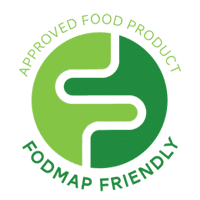
Many people have the mistaken notion that FODMAP Friendly is a lesser FODMAP resource than Monash University. We disagree and hope that this article will help you understand why.
Reputable Resources
EVERYONE following the low FODMAP diet should have both the FODMAP Friendly and Monash University apps. Period. No excuses. It is the most foolproof way to have reliable, current, up-to-date information on FODMAPs at your fingertips from the two most reputable sources.
Please read our article How To Use The FODMAP Friendly App, as a companion piece to this article.
FODMAP Friendly uses a third-party lab for their FODMAP testing, DTS Laboratories, in Australia, which is well regarded and also used by companies such as Coca Cola, Nestlé, Heinz, Campbells, Coles, Unilver and many others.
If an ingredient or product is not in the app, then it has not been lab tested for FODMAPs with publicly reported findings.
Why Lab Test For FODMAPs?
FODMAPs are responsible for a wide variety of IBS symptoms. FODMAPs are carbohydrates that are present in fruits, vegetables, grains, flours, pasta, beverages, baking ingredients, dairy, alt dairy products, condiments, cookies, snacks, crackers (and more!) and even dietary supplements and we cannot know their FODMAP content without lab testing.
FODMAP Friendly and Monash University are the two entities that are lab testing individual ingredients and commercially prepared products, including supplements, for FODMAP content and publishing the results publicly.
We suggest reading our article, Monash University Lab Testing Explained, as well.
Proteins & Fats Contain No FODMAPs
Pure proteins like beef, lamb, pork, chicken, turkey, fish, shellfish and eggs, as examples, do not contain FODMAPs, and do not need to be lab tested.
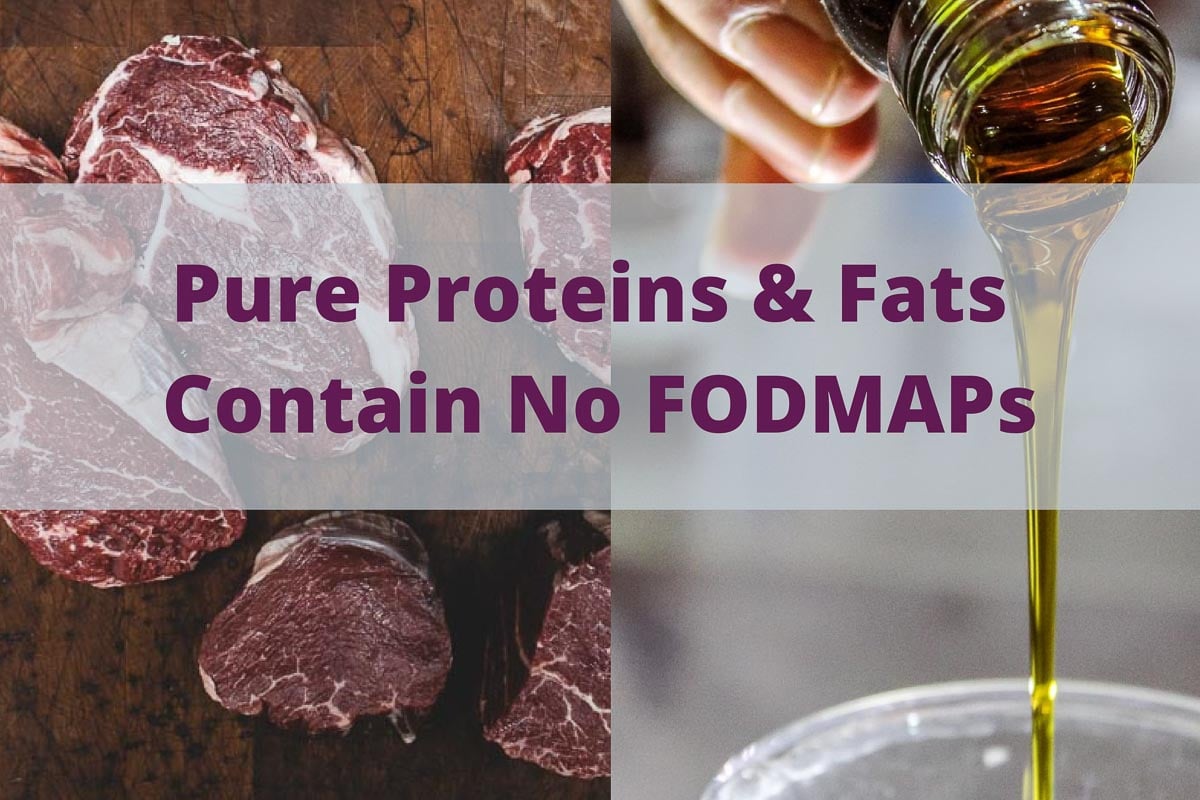
Pure fats such as oils – no matter the source, like coconut, olive, vegetable, canola, sesame, peanut, almond, walnut, rice bran etc. – contain no FODMAPs and therefore do not have to be lab tested in order to know that they contain no FODMAPs.
Foods that contain carbohydrates, however, need to be lab tested in order for us to learn what kind, or multiple kinds, of FODMAPs they contain, and also how much in terms of quantity.
FODMAP Friendly’s Lab Testing Protocol
FODMAP Friendly uses BVAQ/DTS labs, which are NATA (National Association of Testing Authorities) accredited and the largest and most highly regarded lab in Australia. According to Joanna Baker APD AN RN most of the foods in Australian supermarkets has been though BVAQ testing. Also, their labs test for FODMAPs according to Food Standards Australia New Zealand (FSANZ) guidelines.
In personal correspondence with FODMAP Friendly and BVAQ (formerly DTS laboratories), where tests are performed, we have been told that FODMAP Friendly uses 6 different samples and test those samples 3 different times. The samples are gathered by FODMAP Friendly and given to the lab.
Freeze-Drying Plays A Role
All the labs (those used by Monash University and FODMAP Friendly) work in a similar fashion in that they freeze-dry most items first. The freeze-drying laboratory equipment can freeze up to -166°F (110°C).
According to FODMAP Friendly protocol, there are exceptions, such as pure fats like oils and mayonnaise. For FODMAP Friendly, fat samples are “homogenized, weighed and extracted at a high temperature in water. Samples are filtered with regents and then tested.”
Once we were aware of the freeze-drying approach, we asked FODMAP Friendly if this meant, by default, that freeze-drying does not affect FODMAPs. Here is their response – Kiarra Martindale, Accredited Practising Dietitian, BBiomedSc, MDiet and former Business Development and Marketing Manager for FODMAP Friendly stated the following:
“Yes it certainly is under that assumption, however we do believe FODMAP content can vary with each item, where products are grown, sourced from and how they are processed.”
After freeze-drying, the samples are processed one of three ways: via high-pressure liquid chromatography (HPLC), using enzyme test kits, or a combination of the two. Foods might be re-tested if there are any unusual findings, as an extra measure of quality control to ensure reliable results.
The lab provides results for 100 g portions, and those results contain information on the FODMAP levels of fructose, glucose, lactose, mannitol, sorbitol, fructans and GOS. These findings are then given to FODMAP Friendly. Dietitians review the data and determine the food’s status per FODMAP thresholds that are known to trigger IBS symptoms in most people; this gives us a low FODMAP serving size. They also determine the threshold of the serving size where the food would become high FODMAP, which is very helpful.

Why Are There Lab Result Discrepancies?
You might have noticed that you can look up the same product on the Monash app and the FODMAP Friendly app and the results reported might be different – not always, but discrepancies do appear. What does this mean?
Let’s look at one example – Avocado.
Monash University lab testing reports that avocado is low FODMAP at 30 g, or what they call “an eighth of an avocado”; this volume amount means nothing, BTW. Their details state that the avocados they tested contain sorbitol.
FODMAP Friendly lab testing initially reported that avocado had a low FODMAP “Pass” at 120 g (4.23-ounces). The details stated that avocados tested contained mannitol, fructans and some excess fructose. They recently re-tested both ripe Hass avocado and unripe Hass avocado. The lab testing reports that both ripe and unripe get a “Pass” at 80g (2.82 ounces). Their details state that both the ripe and unripe avocados were low in all FODMAP groups, and in fact both ripe and unripe have a max low FODMAP serving size, as determined in the lab, to be 1000 g (that is not a typo).
Yes, at first glance there is a lot to unpack here. The low FODMAP amounts are vastly different, and even the FODMAPs reported in the respective labs and represented on the apps are different. This is not a problem, or an issue of one app being “right” and another “wrong”.
Let us focus on the basics – the different serving size amounts that are stated as low FODMAP, and the types of FODMAPs reported.
Understanding the Lab Results
When it comes to ANY lab, there can be differences in results. It is just like when you get blood work done. It is usually suggested that any follow-up bloodwork for comparison sake should be handled by the same lab. Why? Because labs can differ.
Labs can have different equipment, with different levels of sensitivity and they can be calibrated well, or not. And then there are the food samples themselves. They can be gathered from different sources and can be prepped in different ways, and lab technicians can have varying levels of expertise. Simply put, there are variables.
Especially with produce (fruits & vegetables), variances will occur. No matter what. Here is a simplistic example for sake of explanation:
- You could take 2 bananas from the same tree at the exact moment, store and handle them the same way, send them to two different labs and potentially get different results.
- Two bananas of the same variety, but from different country of origin, can show different FODMAP content, which likely relates to factors such as growing conditions and climate.
- Lab techs can prepare samples differently, and different brands or versions of lab equipment can have various levels of sensitivity, or be calibrated differently.
- You could take those same 2 bananas, store, handle and transport them differently, send to the same lab and get different results. Storage and handling can affect FODMAP levels.
- You could take 2 bananas off of the same tree, but on different days and get different results from the same lab. Ripeness can affect FODMAP content. Ripe bananas have higher FODMAP content. Ripe guavas have lower FODMAP content. And, possibly most interesting, FODMAP Friendly lab testing showed ripe and unripe Hass avocados to contain the same FODMAP content.
- And you certainly can take 2 different varieties of bananas, obviously from two completely different trees, harvested at different points in their ripeness, growing in different conditions, and get different results, regardless of the lab.
There are two main factors here. Different labs, and different samples, can and most likely will produce varied results – all of which are accurate for the samples tested.
Different labs, and different samples, can and most likely will produce varied results – all of which are accurate for the samples tested.
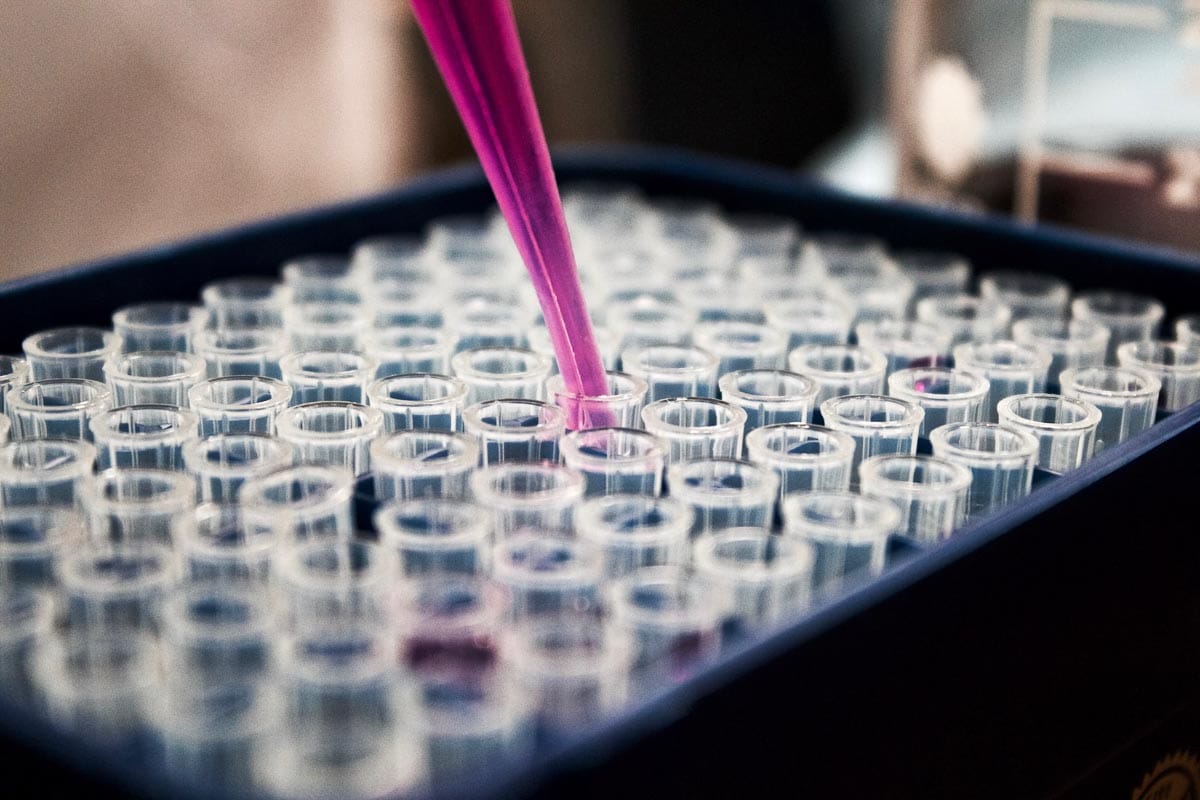
FODMAP Friendly On Lab Testing
Here is FODMAP Friendly’s disclaimer in regard to lab testing:
“The values expressed for all foods and food products is quantitative data from NATA Accredited laboratory results. FODMAP values may vary from sample to sample FODMAP content in foods may vary due to many factors including ripeness, source of origin, storage and processing. This data is only intended to be as a reference for approximate FODMAP levels. Please note that these values are only correlated to the intended serving of each item”. (Bolding and italicizing is ours for emphasis)
We are thrilled that FODMAP Friendly includes this statement right on their app as it is an aspect of lab testing that most people do not understand. These lab values are just lines in the sand – a place to begin your exploration of your relationship to FODMAPs. They are accurate for what was tested at the time – which will be different from what you eat. You will not be eating an avocado from the same batch that was tested.
Please also note that the FODMAP Threshold cut-off values that FODMAP Friendly uses are slightly different from what Monash University uses. Here is the information that FODMAP Friendly uses to assess low FODMAP serving sizes. (You can see the Monash and FODMAP Friendly charts side-by-side in our article that dives deeper into why their lab results differ.
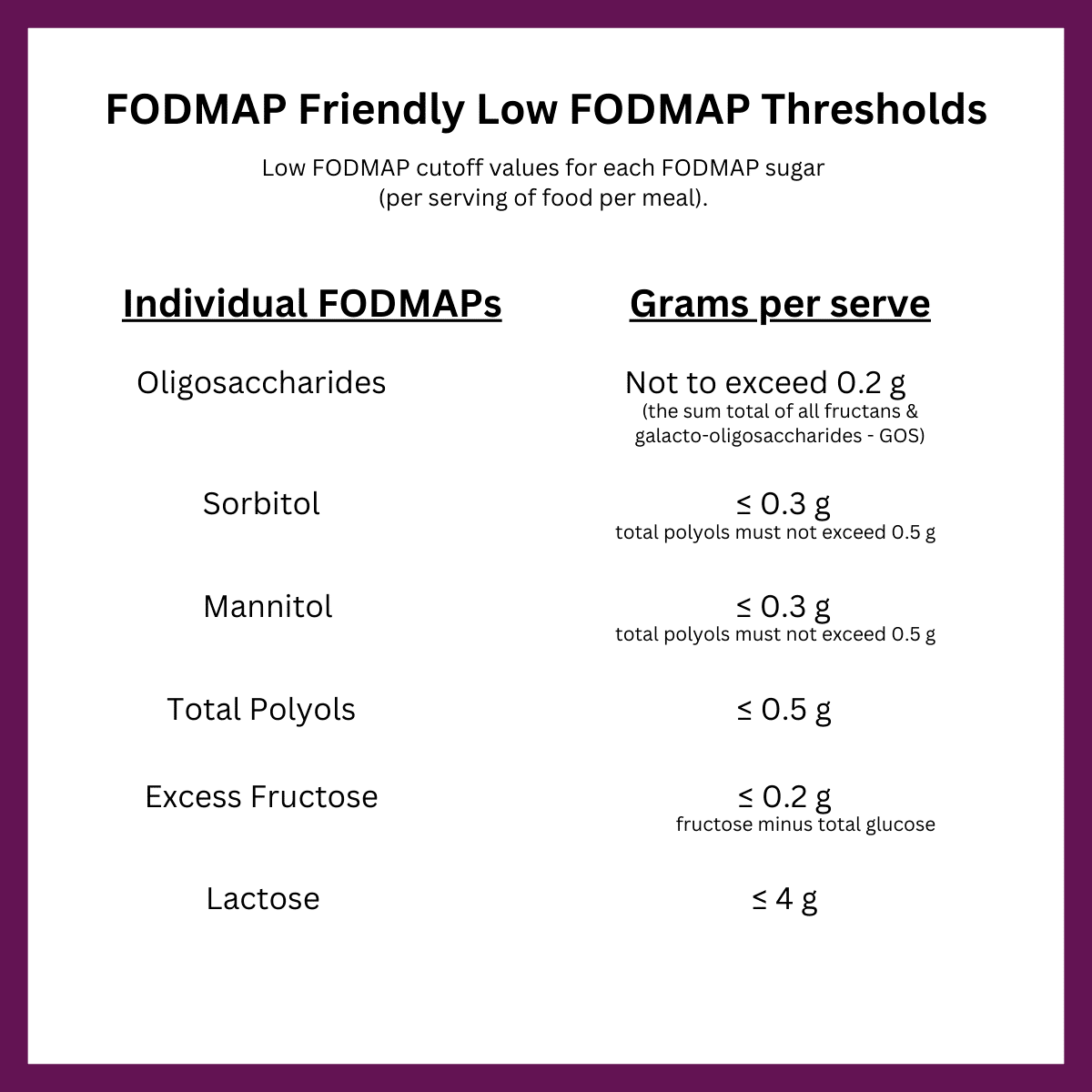
What Lab Test Results Mean To You
What lab tests give us is a baseline. At one point in time Monash University lab testing showed results “X” with avocados and FODMAP Friendly lab testing showed “Y”. Neither is “wrong”, and neither is more “correct” than the other. You could use either as your baseline to begin your self-assessment.
You Are Not A Lab
The real heart of the matter is that you are not a lab. The app results present the lab results. You might not even be able to eat the low FODMAP amount of a food as listed without triggering symptoms. Or you might be be able to eat double. During your Challenge Phase you might fine tune your digestive tolerances even further and determine that you can eat double the amount, but not 2 days in a row. Your personal tolerances are what are important.
This is why structured Elimination and Challenge phases are essential – so that you can keep track and progress – and statistically and anecdotally you will have the best chance of success if you undertake the diet along with a Registered Dietitian. Note that we said structured and not strict. Some of you might benefit from the Gentle Diet approach, but again this is best determined by a dietitian, or the equivalent in your country.
Also, it is very important to remember that not everyone’s IBS symptoms are triggered by FODMAPs. If you get inconsistent results with the low FODMAP diet, it may very well be that something else is triggering your symptoms.
Here are a few of articles that you might find helpful.
- What Is A Low FODMAP Serving Size?
- High FODMAP Foods With Low FODMAP Serving Sizes
- How To Read A FDA Nutrition Facts Label
- Food Allergy vs. Food Intolerance: Navigating a Complicated Path

FODMAP Lab Testing Articles At A Glance
Here are all of our other articles that pertain to lab testing for FODMAPs. We suggest that you read them all:
- Monash University Lab Testing Explained
- How To Use The Monash University Smartphone App
- How To Use The FODMAP Friendly Smartphone App
- When Monash University & FODMAP Friendly Lab Test Results Differ
The Takeaway
FODMAP Friendly is one of two entities (along with Monash University) that is currently performing lab testing for FODMAPs and is a reliable, trustworthy primary resource. They are lab testing individual ingredients and commercially prepared products, including supplements, for FODMAP content and publishing results on their FODMAP Friendly smartphone app.
EVERYONE following the low FODMAP diet should have their app. No excuses!
Lab test results published by FODMAP Friendly are reliable, even when they differ from lab tests reported by Monash University. It is actually to be expected that fresh produce, in particular, will produce different results when tested at different times and in different labs.
Use lab results as a baseline from where to start your exploration of FODMAPs during your Elimination Phase.
Just because something is deemed low FODMAP in a lab doesn’t guarantee that it will not trigger IBS symptoms for you. Lab tests are “real” and conclusive, but you are not a lab.
Working through your Elimination and Challenge Phases in a structured fashion is the best way to learn your own individual relationship with FODMAPs, and doing so with a Registered Dietitian statistically, and anecdotally, will bring you closer to success.
All of our recipes are developed using the most current FODMAP Friendly and Monash University science at the time of initial publication.
If a food is not listed in the apps, it is because it has not been tested. Please do not ask whether an untested food is low FODMAP, because without lab testing no one knows.
Now, get out there, use the FODMAP Friendly app, dive into our recipes and learn to THRIVE on the low FODMAP diet.
